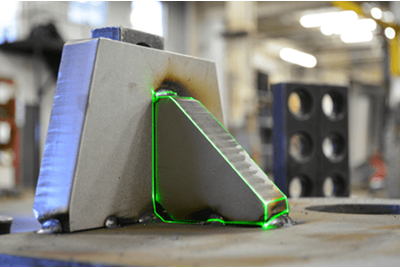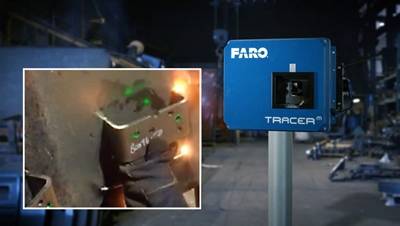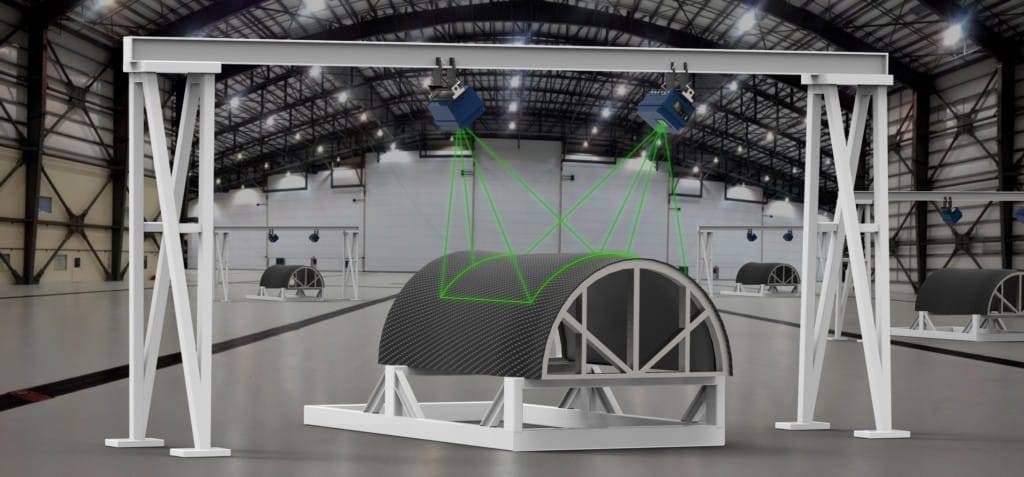Much of today’s manufacturing involves the use of physical templates which can be costly and cumbersome. To increase efficiency and reduce scrap/rework, forward-looking manufacturers have turned toward Laser Projection for templating in applications such as assembly, composites layup, welding, verification, and paint templating.
What is Laser Projection?
 Laser Projection is an assembly assistance tool that guides operators through the build process by projecting a visual template onto the work surface. This template is generated directly from a 3D CAD design model, ensuring up-to-date and accurate information. This information is created and stored, ahead of time so the operator of the system has all of the information needed at the time required. The laser projector displays a laser image on the work surface outlining parts for welding, hole locations for drilling, or other assembly operations. Users quickly and easily cycle through the build procedure following the steps as they are laid out in front of them.
Laser Projection is an assembly assistance tool that guides operators through the build process by projecting a visual template onto the work surface. This template is generated directly from a 3D CAD design model, ensuring up-to-date and accurate information. This information is created and stored, ahead of time so the operator of the system has all of the information needed at the time required. The laser projector displays a laser image on the work surface outlining parts for welding, hole locations for drilling, or other assembly operations. Users quickly and easily cycle through the build procedure following the steps as they are laid out in front of them.
A laser projector creates these accurate images using very precise turning mirrors that steer the beam through space. Known reference points are located to create a virtual alignment of the projector onto the coordinate system of the part. This best fit enables the projector to provide high-accuracy projection images. These mirrors allow the system to project any type of part geometry that may be required. Laser projection can be used to project on areas from 6-50 feet, and if a larger volume is required multiple units can be used together for full coverage.
When to Use Laser Projection?
Laser Projection is used when throughput needs to be increased, scrap and rework need to be decreased, and accuracy needs to be improved. The user-friendly software with the ability to provide multiple images at one time allows users to work quickly and efficiently. A visual laser image cannot accidentally be placed upside down or backwards, as with a physical template. Laser projection provides a standard workflow so all operators perform the tasks as instructed, greatly reducing human error.
Laser projection is typically required where physical templates are cumbersome or inadequate, assembly tolerances are strict, and users need a clear assembly process, free of confusing drawings. Laser Projection software guides the operator through the build process, providing all necessary information at the time it is needed without extraneous distractions.
Laser projection can easily be used by a workforce that does not need advanced technical training. The workflow is designed to be very easy to use and does not require a certified metrologist or trained engineer to run.
How Can Laser Projection Improve the Process?
 The precision system displays highly accurate templates that may result in a 50% to 75% reduction in build time and an 80% to 100% reduction in rework costs, based on information from some of FARO’s TracerM users.
The precision system displays highly accurate templates that may result in a 50% to 75% reduction in build time and an 80% to 100% reduction in rework costs, based on information from some of FARO’s TracerM users.
Projection reduces the need for tape measures, physical templates, and tooling. Oftentimes, physical templates are expensive to create, take up a lot of space on the shop floor, subject to wear and physical damage, and need to be updated or scrapped frequently.
The laser projection information is stored entirely on a computer, which eliminates the cost of having to build physical templates, maintain those templates and then make changes to or scrap those templates with engineering changes. The “soft” data allows the laser template to be updated and changed at any time at no cost.
With virtual data, each projector is capable of projecting a wide variety of work tasks, so one unit is completely flexible to work with any part that may come through the work cell. These systems do not need to be dedicated to specific parts or jobs and can be used anywhere in the facility.
Laser projection reduces the human error aspect, ensuring all operators follow the same procedure as laid out by the system. Errors or discrepancies from one part to the next based on misinterpretation from the operator will be eliminated.
